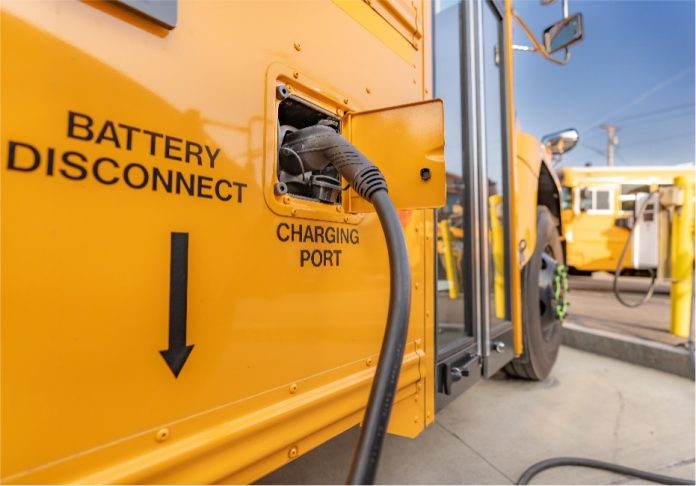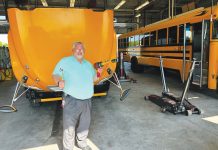Whether you’re a fan or critic of the electric vehicle (EV) movement, there’s no denying electric buses offer some real advantages. But at least for now, impressive range isn’t one of them. With distance potential affected by everything from battery basics to weather and terrain, electric school buses (ESBs) can pose challenges for transportation leaders seeking to optimize their routing.
According to the World Resource Institute, ESBs typically have a range of 100 to 220 miles per charge, depending on the type of bus and its battery configuration. And while one manufacturer now claims a 300-mile range, that’s in perfect-world conditions and still less than diesel or propane, which have more options on the open road for refueling.
Given such limitations, districts venturing into the world of electric vehicles have found it wise to embrace some strategic thinking when it comes to efficient routing.
Living Within Limits
Orange Unified School District in Southern California, which has been building its ESB fleet since 2021, is taking a cautious approach to adoption amid a state regulation that will require zero-emissions school bus purchases starting in 2035. The district currently has 17 electric buses in a fleet of 119.
“Currently, we schedule EV buses on home-to-school routes and/or field trips that are local to our bus yard,” said Christina Celeste-Russo, director of transportation. “This allows our drivers to become familiar with each bus and the range and battery life. It also allows drivers to provide feedback to management staff on how each bus performs.”
She noted that terrain, ambient temperatures, bus weight and the number of stops on a route can affect the battery life on electric buses. For example, steeper inclines will dictate energy demands that may cause energy loss within the electric drive system. These considerations are not only causing anxiety in the state’s rural school districts but also urban and suburban ones like Orange Unified.
“Our team has many logistics to consider when routing EV buses because of the range these buses currently offer,” Celeste-Russo noted. “We’ve experienced issues when scheduling them on home-to-school routes, followed by field trip assignments.”
Often, drivers will pre-trip two buses per day to ensure they have enough range and battery life to complete their daily route and trip assignments successfully, she added.
Meanwhile, Franklin Pierce School District in Tacoma, Washington, has also moved incrementally in adopting electric buses. The district obtained its first ESB in 2017. It then incorporated three more into its overall fleet of 65 buses last summer. In the process, staff have learned to minimize routing challenges.
“We don’t move the buses from route to route,” noted Tim Bridgeman, director of transportation. “Once we find a route they work on they don’t move, and routing takes into account they’re e-buses before making any changes.”
In the process, charges are closely monitored. “We check the overall a.m. and p.m. mileage to make sure the buses can make the runs in the a.m. then return to get enough charge to do the p.m.,” Bridgeman said. “This can be tough during early release days.”
In supporting field trips, electric vehicles are ruled out. Sometimes this means drivers must return to the yard and switch buses.
For San Diego (California) Unified School District, experience gained with its current cohort of 13 electric buses (out of a total fleet of 460) will be applied as 30 more ESBs are obtained. The new acquisitions will be supported by a $12.4 million grant through the EPA’s Clean School Bus Program grants.
In the early stages of integrating ESBs into the district’s fleet, the vehicles occasionally had to be towed back to the transportation yard after a fully depleted charge, noted Maintenance Manager John Burciaga. To avoid such problems, a minimum charge of 75 percent is now required before any electric bus can leave the transportation yard. And routes are limited to a maximum of 60 miles, allowing for the full recharge of a bus following a three-to-four-hour morning or afternoon route.
Editor’s note—The maximum ESB battery charging capacity is often limited to 80 percent for safety considerations. Check with individual manufacturers for more information.
“As the district’s EV fleet grows, consideration will need to be given to offsite charging capabilities away from the transportation yard,” Burciaga said. “This will allow charging between morning and afternoon routes without having to return to the transportation yard.”
He noted that several factors should be considered for optimum routing. They include the amount of driving time on surface streets versus the freeway, since the regeneration rate is greater on surface streets. The number of wheelchair positions on the bus is another consideration, as the wheelchair lift draws from the 12-volt system that is recharged from the high-voltage vehicle drive battery. In addition, warmer months require shorter routes due to air conditioning usage. To take these and other considerations into account, driver training on how best to maximize power usage is important, Burciaga added.
Training has also been a focus in South Carolina, which has developed an operator certification program for drivers of electric vehicles and requires all ESB drivers to complete it. The program includes classroom learning, simulator training, and on the road driving experience. The training is provided with three mobile simulators, which are relocated and set up in front of the buses being deployed in each district.
“These simulators help us evaluate how well drivers are adjusting to the specific operational characteristics of the EV bus,” explained Mike Bullman, director of transportation for the South Carolina Department of Transportation. “The comprehensive training and evaluation process not only enhances driver efficiency but also helps alleviate any potential anxiety associated with driving an all-electric bus.”
The ESBs make up a growing proportion of the state’s bus fleet. South Carolina currently has 25 electric buses in operation, with an additional 139 at various stages of deployment. Once fully deployed, a total of 168 ESBs will operate in 17 different school districts across the state, with deployment sizes ranging from four to 20 units.
That will represent about 3 percent of the state’s total fleet of 5,200 route buses, in some districts accounting for as much as 15 percent of the fleet. To date, the ESB experience has been largely positive. “We haven’t come across any significant issues
specifically related to the electric components or the functionality of these EVs,” he noted.
“In fact, the incidents that have occurred have been minor problems which are common to any fleet of vehicles, regardless of the power source.” Overall, the transition to electric vehicles has been smoother than expected, he added, and the performance of electric buses continues to exceed expectations.
Through training and lessons learned from everyday practice indicates route planning for electric buses is based on avoiding situations that exceed their capacity. “Our primary considerations when determining the best routes are route length and whether any mid-day trips are assigned to the bus,” Bullman said.
New Opportunities
The routing limitations of electric vehicles can present new opportunities for creative thinking, noted Robert Jacobus, founder and CEO of Colorado-based consulting firm School Bus Logistics.
“Evaluating EV in a district should bring a fresh look at the routes for efficiencies,” he said. “This opens the door to think outside of the box when it comes to routing, like
we have for the past 80 years.”
Along with considering new angles on routing efficiency, this might include simple measures such as changing wording or numbering. “I guess we now have to come up with new nomenclatures for our route package numbers,” he said. “Maybe placing ‘EV’ in front of the route number now so dispatch knows if a route can be run with an EV bus.”
In the future, routing challenges for electric school buses are likely to become a non-issue as batteries and related technologies keep improving. In the meantime, the distinct capabilities and limitations of ESBs, along with effective strategies for their optimum use, will bear careful consideration.
“Start by engaging closely with your utility providers” Bullman said. “I can’t stress this enough, not only for their technical support, but also for obtaining equipment and other related logistics on time.”
Care in selecting charging equipment is a must, added Bridgeman in Washington. “Significantly research the chargers you intend to use before purchasing them,” he said. “Make sure the buses and chargers are compatible, and do not purchase chargers that have never been used to charge school buses.”
He also advised against using chargers that have internal batteries for charging during peak demand times. “These charges are not effective when the batteries get depleted,” he added. “They begin to slow down the charging rate to the buses.”
Burciaga in San Diego advised identifying key partners early in the process and ensuring communication between each. “Start small and adapt to your needs,” he said. “Recognize
that technology is constantly improving and resist the temptation to move too quickly.”
Editor’s Note: As reprinted in the June 2024 issue of School Transportation News.
Related: Electric School Buses, Microgrids Support Community Resilience
Related: Rural Districts Discuss the Move Toward Electric School Buses
Related: Preparing for Electric School Bus Infrastructure
Related: (STN Podcast E211) Future-Facing: State of School Bus Sustainability, Electric Buses Travel Michigan’s Dirt Roads














